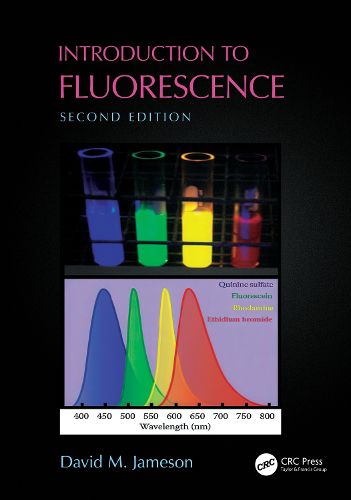Readings Newsletter
Become a Readings Member to make your shopping experience even easier.
Sign in or sign up for free!
You’re not far away from qualifying for FREE standard shipping within Australia
You’ve qualified for FREE standard shipping within Australia
The cart is loading…






The phenomenon known as 'fluorescence' is now widely used in the chemical, physical and life sciences largely due to the development of highly sophisticated fluorescent probe chemistries and the commercial availability of these probes as well as the development of novel microscopy approaches. This Second Edition of Introduction to Fluorescence helps readers acquire a thorough understanding of basic fluorescence theory and practice. It describes the general principles in a direct way and uses examples from a variety of disciplines to demonstrate them. Since the First Edition, significant advances in the field have appeared. For example, phasors, both lifetime and spectral phasors, have become very popular, and so a new chapter dedicated to this topic has been added in this edition. Furthermore, significant advances have been made in fluorescence microscopy methods, including super-resolution and single-molecule techniques.
In color throughout, the book takes readers through the history of important discoveries to the most current advances. It introduces the fundamentals of the fluorescence phenomenon and gives detailed examples of fluorescence applications in the molecular life sciences, including biochemistry, biophysics, clinical chemistry and diagnostics, pharmaceutical science, and cell and molecular biology. The author presents the basic theories underlying the applications and offers in-depth information on practical aspects.
Numerous references are given in each chapter, along with a list of particularly important references at the end of each chapter. The text incorporates more than 340 figures that clearly illustrate the concepts and gives the chemical structures of the most widely used fluorescent molecules. In addition, Chapter 13, the Appendix, provides a "Rogue's Gallery" of the most common errors and pitfalls to avoid.
$9.00 standard shipping within Australia
FREE standard shipping within Australia for orders over $100.00
Express & International shipping calculated at checkout
Stock availability can be subject to change without notice. We recommend calling the shop or contacting our online team to check availability of low stock items. Please see our Shopping Online page for more details.
The phenomenon known as 'fluorescence' is now widely used in the chemical, physical and life sciences largely due to the development of highly sophisticated fluorescent probe chemistries and the commercial availability of these probes as well as the development of novel microscopy approaches. This Second Edition of Introduction to Fluorescence helps readers acquire a thorough understanding of basic fluorescence theory and practice. It describes the general principles in a direct way and uses examples from a variety of disciplines to demonstrate them. Since the First Edition, significant advances in the field have appeared. For example, phasors, both lifetime and spectral phasors, have become very popular, and so a new chapter dedicated to this topic has been added in this edition. Furthermore, significant advances have been made in fluorescence microscopy methods, including super-resolution and single-molecule techniques.
In color throughout, the book takes readers through the history of important discoveries to the most current advances. It introduces the fundamentals of the fluorescence phenomenon and gives detailed examples of fluorescence applications in the molecular life sciences, including biochemistry, biophysics, clinical chemistry and diagnostics, pharmaceutical science, and cell and molecular biology. The author presents the basic theories underlying the applications and offers in-depth information on practical aspects.
Numerous references are given in each chapter, along with a list of particularly important references at the end of each chapter. The text incorporates more than 340 figures that clearly illustrate the concepts and gives the chemical structures of the most widely used fluorescent molecules. In addition, Chapter 13, the Appendix, provides a "Rogue's Gallery" of the most common errors and pitfalls to avoid.